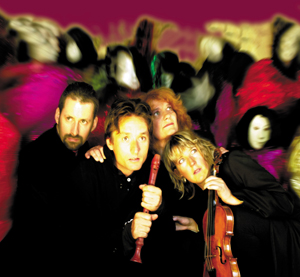|
Other
CHARMING "BARBER" A MENDO FESTIVAL TRIUMPH
by Pamela Hicks Gailey
Friday, July 21, 2023
Other
JOYFULLY WE SING
by Pamela Hicks Gailey
Thursday, February 23, 2023
Other
SUBDUED PIANISM IN RARE FORTEPIANO RECITAL IN THE RAVEN
by Terry McNeill
Sunday, February 12, 2023
Other
DINOVA PIANISM CHARMS SATED AUDIENCE AT J-B MARIN RECITAL
by Terry McNeill
Sunday, November 20, 2022
Other
CLEARY'S NEW ORLEANS BAND IGNITES PARTY FOR THE GREEN AT SSU
by Terry McNeill
Saturday, September 25, 2021
Other
SIX GUITARISTS IN UNIQUE NAPA RECITAL
by Gary Digman
Sunday, July 25, 2021
Other
STUNNING LINCOLN CENTER CONCERT LAUNCHES FIFTH WEILL SEASON
by Philip Beard
Saturday, October 1, 2016
Other
LATE BEETHOVEN EXPLORED AT MMF CONCERT IN PRESTON HALL
by Paula Mulligan
Thursday, July 21, 2016
Other
ANGUISH AND TRIUMPH IN MENDOCINO FESTIVAL'S BIG TENT
by Kayleen Asbo
Sunday, July 10, 2016
Other
ARCANE ARENSKY TRIO HIGHLIGHTS NAVARRO'S SEASON OPENING CONCERT IN SCHROEDER
by Terry McNeill
Sunday, October 4, 2015
|
 |
 Red Priest in Fear of Halloween at Wells Center |
RED PRIEST TAKES A HALLOWEEN TOUR OF BAROQUE EUROPE
by Joanna Bramel Young
Sunday, October 25, 2009
What better time than Halloween to experience a “fantastical” performance of baroque music? On Oct. 25, the touring group Red Priest transformed the formal Wells Center stage into an area of demons, ghosts, strange dreams and wild dances. Produced by the Santa Rosa Concert Association, the event had colorful stage lighting that added to the drama, the 800-person house giving excited applause throughout.
The performers included Piers Adams, recorders, David Greenburg, violin, Angela East, cello, and Howard Beach, harpsichord. The chosen theme was Venice and Antonio Vivaldi (the “Red Priest,” 1678 to 1741) the chosen mentor. For the opening piece, Vivaldi’s nightmare concerto “La Notte," members of the ensemble entered the stage stealthily, one by one, wearing hooded black and red capes, helping to bring the piece to life. The group played the entire concert without written music, a feat in itself, but additionally the playing was of the highest virtuosity. Piers Adams was the star, taking the technique of recorder playing to new heights. Recorder and violin gleefully sparred, seeing who could play the slow sections with more emotion and the fast sections with more speed and passion.
Although there was clowning among the players (bringing titters to the delighted audience), the essence of the baroque style was seldom lost. Improvisation, ornamentation, hesitations, abrupt change of tempo and variety of articulation are all aspects of baroque style. After all, the term “baroque” is supposed to derive from the Portuguese “barocco” (a misshapen pearl). The French used the term to mean “odd, rather absurdly irregular.” All four players are obviously informed about baroque technique, and they are simply taking the variety of changing emotions inherent in the music in new directions. Most pieces retained their true essence. Here and there this reviewer felt that a piece was played so fast that one lost track of the melody, but most of the pieces lent themselves well to this heightened interpretive approach. Several works were played “straight” with no shenanigans, including Bach’s Prelude and Fugue from Suite No. 5. Cellist Angela East played it with rich expressiveness, in contrast to a piece where Ms. East wrapped a long sash around her back, tied it to the cello and walked about the stage strumming the cello like a guitar.
Henry Purcell’s moving “Two and One Upon a Ground,” played quietly and without visual elaborations, was given a memorable performance by the ensemble. Jacob Van Eyck’s wonderful bird piece, “The English Nightingale,” lends itself to freedom of expression in the amazing bird chirpings and trills. The work is a Dutch 17th-century set of variations, each more brilliant than the last. Adams’ little soprano recorder negotiated its intricacies with cliff-hanging virtuosity. Corelli’s famous variations on La Follia, originally written for violin, harpsichord and cello, were played here with recorder and violin sharing the spotlight. The variations go on and on, and somewhere in the middle the harpsichordist (quite the comic actor) throws up his hands in boredom and falls asleep with his head on the keyboard. He then revives and the variations continue, suddenly morphing into East Indian sitar-like music with the players sitting cross-legged on the stage. Of course the work ends in fireworks.
Red Priest can be enjoyed by people who are informed about early music, but also by general concertgoers. Works that are often heard played in a more restrained style suddenly leap out at you, delighting the senses. The English musicologist and broadcaster George Pratt wrote, “If nobody goes over the top, how will we know what lies on the other side?”
|
